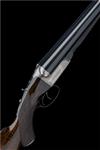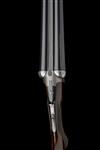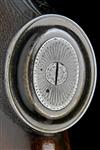Product Details
WILLIAM POWELL & SON
A 10-BORE ( 3 1/2IN.) 1864 PATENT LIFT-UP TOPLEVER BOXLOCK NON-EJECTOR, serial no. 7130,
30in. nitro reproved barrels (some movement on action), the rib engraved 'WILLIAM POWELL & SON. 13 CARR'S LANE. BIRMINGHAM. PATENT.', 3 1/2in. chambers, bored approx. true cyl. in both, Anson & Deeley 1875 patent barrel cocking action, patent no. 1756, use no. 2280, incorporating William Powell patent lift-up toplever, patent no. 1163 of 7th May 1864, use number 2300, automatic safety with gold-inlaid 'SAFE' detail, carved percussion fences, fine border and acanthus scroll engraving, brushed bright and re-blued finish overall, 14in. figured pistolgrip stock (pinned at head) including steel buttplate and steel pistolgrip cap, fore-end with Deeley & Edge patent release catch, weight 8lb. 14oz., in a canvas and leather hammergun case
Provenance: The gun is accompanied by a letter from the makers reading:
B.L.N.E. No. 7130
10 Bore
Best Quality gun.
Bored cyl./cyl. to shoot single lead ball cartridges.
Weight of gun when new 9 1/4lbs.
Complete with case and all fittings etc.
Bought new on the 3rd July 1880 by Col. Probyn.
Price £35.00
Later that day the same man returned to buy some 12-bore pinfire cartridges and extras. He spent a total of £53 18 3d on that day.
Research would indicate that this was General Sir Dighton Macnaghten Probyn, VC, GCB, GCSI, GCVO, ISO, PC (21 January 1833 – 20 June 1924) he was a British Army officer and an English recipient of the Victoria Cross, the highest award for gallantry in the face of the enemy that can be awarded to British and Commonwealth forces.
Probyn was 24 years and a captain in the 2nd Punjab Cavalry, Bengal Army during the Indian Mutiny at which time the following events took place:
"(Probyn) Has been distinguished for gallantry and daring throughout this campaign. At the battle of Agra, when his squadron charged the rebel infantry, he was some time separated from his men, and surrounded by five or six sepoys. He defended himself from the various cuts made at him, and before his own men had joined him had cut down two of his assailants. At another time, in single combat with a sepoy, he was wounded in the wrist, by the bayonet, and his horse also was slightly wounded; but, though the sepoy fought desperately, he cut him down. The same day he singled out a standard bearer, and, in the presence of a number of the enemy, killed him and captured the standard. These are only a few of the gallant deeds of this brave young officer."
Despatch from Major-General James Hope Grant, K.C.B., dated 10th January, 1858.
On 4 March 1872, the Prince of Wales, later Edward VII, appointed him as one of his equerries. He was knighted as a Knight Commander of the Order of the Star of India (KCSI) on 7 March 1876, and was brevetted to lieutenant-general on 1 October 1877
He was in later life an ornament of the Victorian age, being Keeper of the Privy Purse, a court sinecure position as well as Secretary to the Prince of Wales and Comptroller of the Household. This was an important position as the Prince and Princess were both profligate in spending and Sir Dighton had a hard job to keep them solvent. Testimony to his success was the fact that, when the Prince acceded at last in 1901, he was in credit at the bank. Probyn had difficulty hiding the King's extravagance; which the minister Charles Hobhouse refused to defend in the Commons.
Probyn continued in this role throughout the King's rule and right up to his death. Sir Dighton was appointed an Extra Equerry to King Edward VII in 1902.
Probyn was totally devoted to the Princess, then Queen-Empress, building gardens for her at Windsor Castle and Sandringham House. The Queen returned the devotion, carrying round a knife with her to cut open his collar when he occasionally had seizures.
Sir Dighton had an impressive appearance in old age with a very long white beard reaching down to his navel which concealed his VC on ceremonial occasions. Probyn died on 20 June 1942 (aged 91) at Sandringham House, Norfolk. He was buried in Kensal Green Cemetery.
The VC earned by General Sir Dighton Probyn, according to The Times, was bought at auction 24 September 2005 for £160,000. Details of the purchaser were not given.
Please click HERE to view Terms & Conditions.
Estimate £800-1,200
S2 - Sold as a Section 2 Firearm under the 1968 Firearms Act










